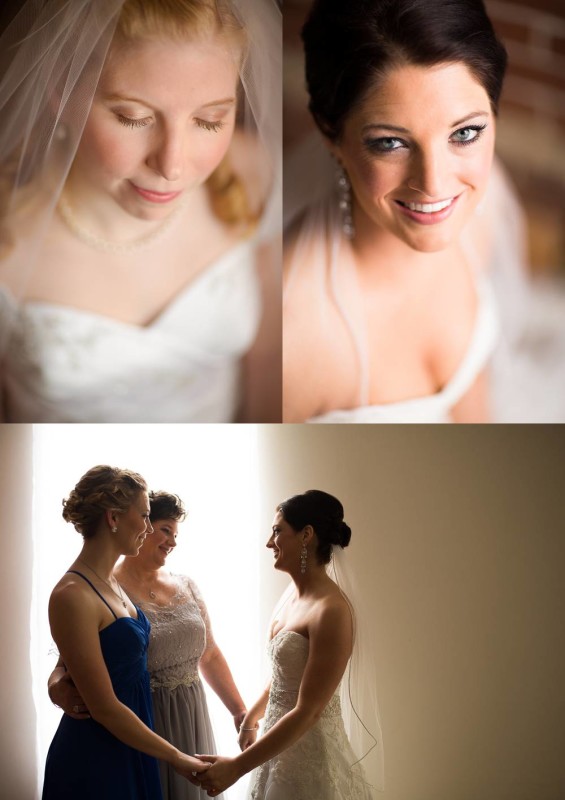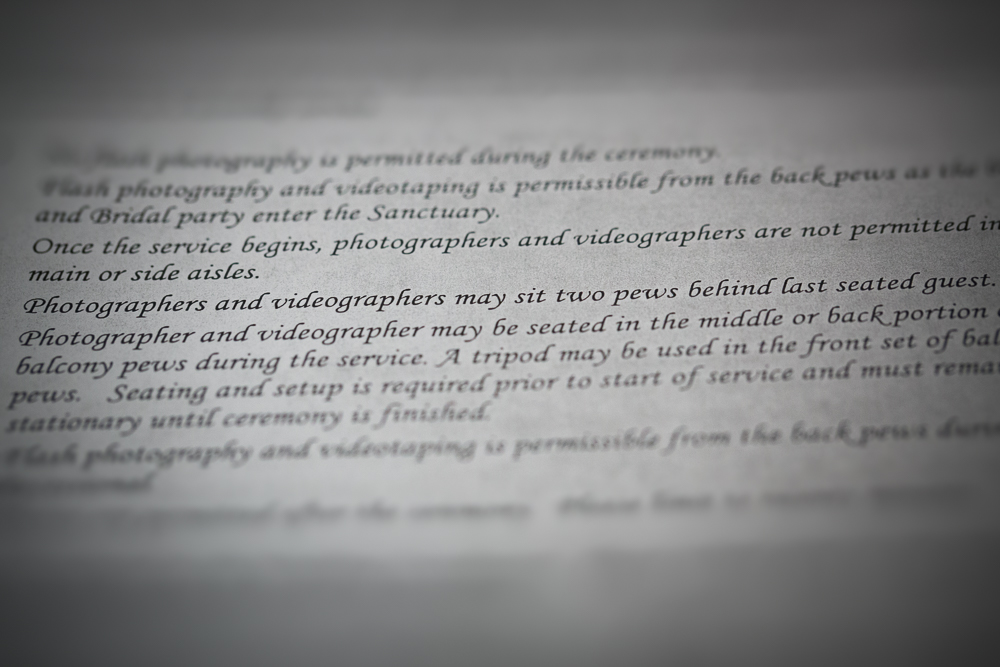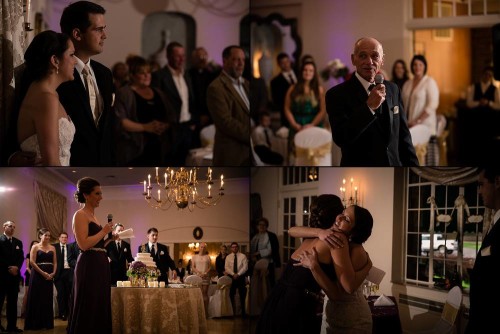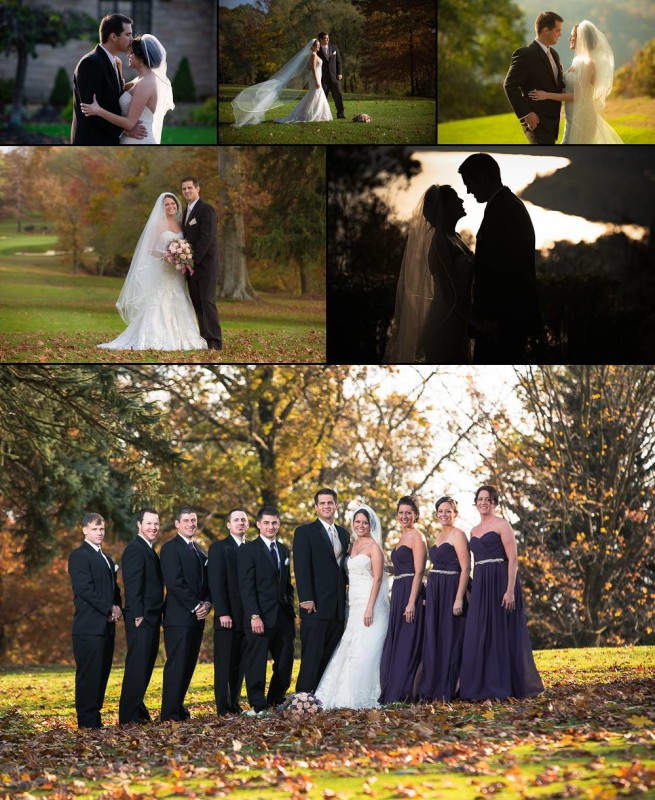We are frequently asked, particularly at this time of year during the height of the wedding planning season, for wedding photography tips and advice. Helpful “do’s and don’ts,” if you will. Tons of resources are available, from bridal and wedding magazines, websites, bridal show publications — you name it.
Most usually give a checklist of questions to ask your prospective wedding photographer:
Are you experienced? Yes, take a look at our blog, portfolio and sample albums.
Do you have a professional studio? Yes and while we are happy to meet you at a convenient location, our studio is located in downtown Wheeling on 14th Street (and if we don’t meet in our studio — a coffee shop is great — both of us kind of run on the stuff…)
Do you carry insurance? Absolutely and we would be glad to provide a venue proof of insurance, if requested.
Tell me about your backup equipment? We actually have back up equipment for our backup equipment. Unfortunately, cameras do break and if one of ours goes down, you won’t notice.
How about our images – how are they backed up? Redundantly, on multiple hard drives stored in different physical locations. The list could go on and on.
When we answer these questions and offer our thoughts, we don’t refer couples to inspiration boards such as Pinterest or talk much about styling trends, etc. No doubt, themes and colors are important details that can add your personal style and feel to your day. While they can add visual interest to a photograph, we would make the case that they don’t make the photograph.
Moments make a photograph. That’s not to say that you won’t remember colors or the fun theme that you carefully coordinated but we suspect that you will probably remember a certain look from your new spouse, an embrace from your grandmother or seeing your father in tears. Our own personal style is not to “create” these moments. What we do best, though, is set the stage, artistically-speaking, allowing them to naturally occur. In literally the best light possible.
In that spirit, we offer a few hints and tips that we notice are most easily overlooked and we hope they differ from the “checklist questions” you probably already know. Regardless, we think attention paid to these points will set the stage for your moments to be captured quite well.
1. Do consider the “Getting Ready” location.
Obviously, this area isn’t overlooked — after all, everyone needs a place to get ready. All too often, however, the actual location is simply chosen for convenience with little, if any, thought given to the actual environment. And we aren’t suggesting that you must have a large, ornate room with high ceilings. The only thing needed for great photographs is a clean room preferably with some window light.
More often than not, when the subject is first discussed with our clients, we learn that the church has a room available. This may be a good option but you really do want to see the room. Make sure that it’s an actual room, large enough for your attendants. Frequently, the “room” turns out to be a little more than a basement closet with no windows. We have actually arrived and found it to be a spare classroom (many churches have elementary or Sunday Schools) or storage room filled with books and desks.
If your own home is not logistically possible, we would recommend a hotel room with room for your bridal party. And remember, we always make our studio space available to Wheeling-area couples.
2. Do be mindful of church and venue requirements (AKA — the Church Rules)
Straight up: any professional photographer worth his or her salt will follow church rules during a ceremony. Please don’t ask us to break them or suggest that we don’t need to follow them.
We always attempt to be as unobtrusive as possible during your ceremony. From staying low to avoid blocking views to moving as quietly as possible up and down the aisles, we want the focus to be on you. We never use flash during a ceremony except for the rare instance of during the processional (and even then, we try to avoid it and only pop a flash when we must). Most churches are perfectly fine with our approach. Unfortunately, we have seen some couples disappointed and panicked when faced with very restrictive church rules on photography – sometimes they simply didn’t pay attention when they scheduled their ceremony and other times the rules were dropped on them, literally, the day of the ceremony.
Indeed, there are many churches where the professional photographer must stay at least two rows behind the last seated guest and is not permitted to move whatsoever during the ceremony. This is where our team approach is helpful.
Because there are two of us, we are at least able to cover two vantage points, even if we are limited in our movement (Jim may be on the floor level, while Ellie will photograph from the back or side balcony, if available). Also, if you are faced with rules that require the photographer to stay behind the last seated guest, a helpful (and easy) tip is to make sure your ushers are seating guests to fill the front rows completely. Many times we notice that guests like to have an end or “aisle” side seat – which means more rows are partially filled and the professional photographer is pushed farther back than necessary. So fill those front rows!
3. Do plan for interaction and reaction on speeches and toasts
Probably our best “engineering” advice on setting the stage for a memorable reception relates to the toast and any speech…and it’s amazingly simple. During the toast, simply create some space between you and the speaker. What usually unfolds is that the DJ or band leader calls the toast and the best man or maid of honor (who is also typically seated right next to the bride or groom) simply stands up and begins speaking. While totally understandable, this inevitably leads to photographs of the new couple craning their necks and twisting to the side to look at the speaker or the couple looks straight ahead or down at their dinner plate. Either way, it just makes us sad as photographers!
What we recommend is having the DJ or band leader call the speaker to the dance floor and to face the new couple. Allow for action and reaction. Which leads to images such as this:
4. Don’t set yourself up for failure — watch that timeline … and Light
Most every couple carefully considers the day’s timeline. Hair, makeup artist, ceremony, cocktail hour… As photographers, though, the importance of timeline is light and client expectation. Understand that with respect to your creative shots, our goal is to provide you with the broadest mix of images as we reasonably can in a condensed time. The following series of images were all taken during a short walk in about a 30 minute time frame. They vary from shots that are silhouette, classic portraits to interactive shots in the sun.
The takeaway and overlooked tip? Consider your expectations and don’t set yourself up for failure! It’s easy to do if you aren’t careful or if you try to condense the day too much. If you have visions of golden outdoor photographs but your late fall wedding ceremony begins at 3:30 p.m. — you will need to think about your timeline or consider alternate arrangements (perhaps you may want to consider a “first look” scenario where we do your creative shots prior to the ceremony). While we work quickly and efficiently, the most important resource you can provide to your photographer is time.
5. Do consider a night time portrait
We often tell our couples that we may approach them once it’s dark outside to see if they want to step outside for some quiet shots of just the bride and groom. In most instances, this would be after open dancing has opened for your reception guests — it’s usually easy to slip away for a few moments and you’ll hardly be missed. These are a great way to balance and add character to your photography coverage of the day.
Bonus Tip — Do Trust
As the saying goes, trust is earned. For that reason, we spend time with our clients getting to know them through the planning process. We provide a comprehensive, detailed form to guide the process (customized for occasions where the couple plans a “first look” to more traditional arrangements). Simply put, your wedding day is not the time to figure out an alternate location for portraits if it suddenly starts to rain.
Many times we will simply place you in a patch of light and tell you to “do anything – talk, laugh, love, tell each other jokes, but don’t look at the camera.” Okay – but what’s the overlooked tip? Trust us and follow our guidance!
Relax. Enjoy your day. Enjoy the moment.



